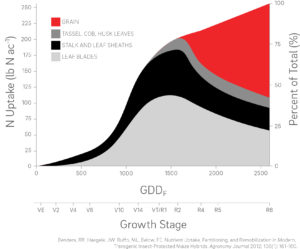An old colleague once urged me to run my work through a filter: Was the action nice or necessary? Think about your nitrogen application plan. Would it change if you ran it through that same filter? Applying all of our N in the fall is nice; it spreads out our workload and makes things easier in the spring. But, is it necessary for growing a good crop? In fact, the opposite may be true. As modern hybrids are taking up more N later in the year and heavy rainfall events are becoming more normal, applying all of our N in the fall is likely not the best strategy from a cropping perspective or an environmental perspective. And, it may be necessary to hold some of your N and adopt a split-nitrogen application plan.
What happens when you apply N?
Once nitrogen is applied to the soil only two things can happen; it can be taken up by the plant or can be lost to the environment via leaching, nitrification or denitrification.
- Nitrification: After anhydrous ammonia (NH3) is applied to the soil, it converts to NH4+, which is the ammonium molecule. Organisms in the soil then begin working to convert the ammonium molecule to nitrite and then nitrate NO3- through the nitrification process.
- Leaching: Because the nitrate molecule is negatively charged like the soil, it can be lost via leaching.
- Denitrification: Also, there are organisms in the soil that will convert the NO3- to a gaseous form that is lost in the atmosphere through denitrification.
These processes are biological in nature and things like temperature, pH, moisture and other factors can drive them to move faster or slower. If we apply all of our N in the fall, we expose our complete nitrogen supply to these processes throughout the entire fall and spring. Although nitrogen stabilizers or inhibitors can slow down this process until cooler fall
and winter temperatures arrive, once the weather warms up in the spring these processes fire back up.
Plants Need N Later in the Growing Season
As you look at the chart to the right you can see that the corn plant takes up approximately 75% of its N after V10. By adjusting your nitrogen management plan and accounting for a late-season N application as close to V10 as possible, or when your crop needs it based on soil nitrate measurement and testing, you can help maximize yields and minimize N loss (and lost inputs) to the environment via leaching and denitrification.
Let Mother Nature Play Her Hand
When applying 100% of N via fall anhydrous you do not know what the following growing season has in store. If it’s similar to 2015 for the Corn Belt, with heavy rain events early in the season, fall and spring applied nitrogen is at great risk for loss. By taking a different approach and saving inputs for mid- to late-season N application we can let Mother Nature play her hand, and we can adjust our plan based on the environment, the season and up-to-date data.
Luckily, tools available today allow us to:
- Apply a solid foundation and base rate of N in the fall or early spring;
- Measure soil nitrate mid-season to know how much N is needed to finish the season; and
- Apply N with precision late in the season when the crop needs it most.
So, as you finish harvest and start thinking about next season, ask yourself if applying all of your nitrogen this fall – or early next spring – is the best use of your inputs. Think about testing out a different approach on one of your fields, and hold back some N for a split-N management plan in 2016. Learn more about laying a good foundation in this blog post with Jamie Brand.